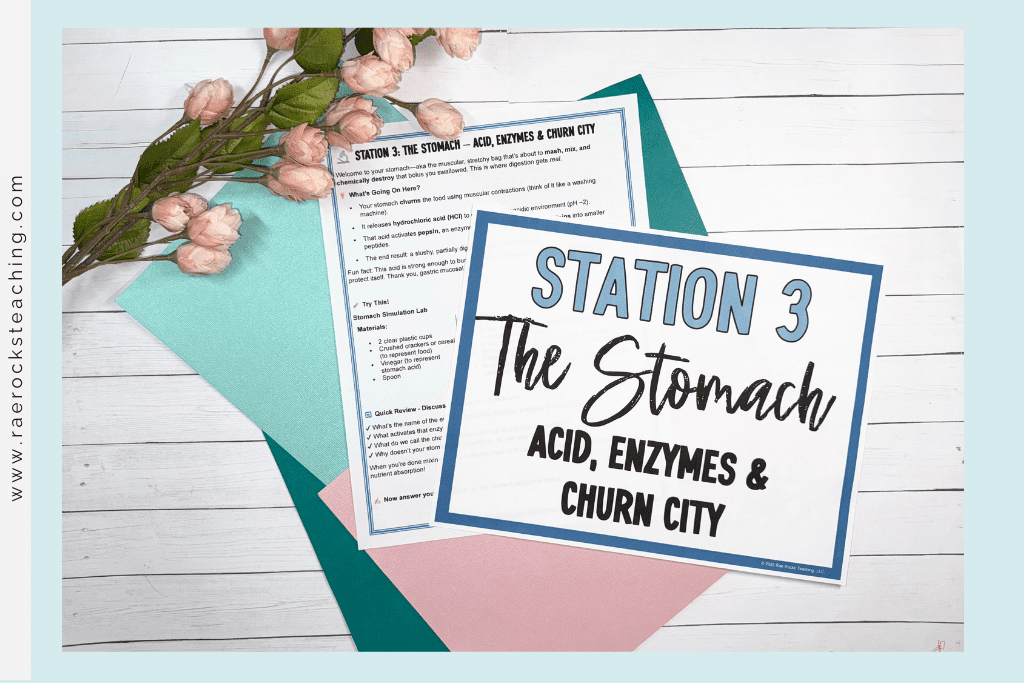If you’re searching for engaging digestive system lab activities that won’t have your students zoning out halfway through class, I have a classroom-tested approach that made a huge difference for me: digestive system station labs.
When I first taught the digestive system, I leaned heavily on lectures and slide decks. And sure, students could define terms like “chyme” and “peristalsis” for the quiz, but they couldn’t really explain what digestion looked like as a full process. It felt disconnected, flat. So I shifted gears and created a station-based lab that walks students through the entire journey—from mouth to anus—in a way that actually makes the content stick.
A Closer Look at the Digestive System Activities Stations
Each of the seven stations focuses on one step in digestion:
- The Mouth (mechanical & chemical digestion)
- The Esophagus (peristalsis simulation)
- The Stomach (acid & enzyme breakdown)
- The Small Intestine (enzyme action and bile emulsification)
- Absorption (surface area simulation with sponges)
- The Large Intestine (water reabsorption and waste formation)
- Elimination (wrap-up and digestive system mapping)
At each station, students complete a short activity—nothing too elaborate, but enough to illustrate the concept in a hands-on way. For example, they might chew a cracker to observe salivary amylase in action, or use pantyhose to simulate food moving through the esophagus. These are simple setups with everyday materials like vinegar, crackers, dish soap, and sponges. They work because they get students to connect content to experience.

-
Save
How I Use the Digestive System Activities in My Classroom
I run the full set of stations in one class period, usually with students working in pairs or small groups. Everyone has a response sheet that they complete as they rotate, and I keep things moving with a timer. I do a quick intro before we start and a class debrief at the end, but most of the work is student-directed.
What’s great about this approach is how flexible and low-prep it really is. I keep each station’s materials in a bin or tray with a clearly labeled instruction card, and it’s easy to reuse the materials year after year. I also have an answer key handy for quick grading, and a setup guide to make my life easier when I’m prepping the day before.
What I’ve Noticed Since Using These Stations
The biggest change I noticed? My students actually understand the digestive system. They can describe each part of the process and explain the role of enzymes, absorption, and waste formation with confidence. And they’re way more engaged. There’s a noticeable shift in energy when students are moving, talking, and grossing each other out (in the best way) at the stomach and large intestine stations.

-
Save
Even my more reluctant learners participate. One student who rarely speaks up in class turned to me during the absorption station and said, “Ohhh, that’s why the small intestine is so long.” Lightbulb moments like that are exactly why I keep doing this.
Why This Works
If you’re looking for digestive system lab activities that promote understanding instead of memorization, stations just work. They break up the class period, allow students to engage physically and mentally, and reinforce key ideas through active learning.
More importantly, they help students see the digestive system as a connected process. Instead of memorizing isolated facts about organs and enzymes, they experience digestion as a series of steps with real cause-and-effect logic.

-
Save
I’ve seen test scores improve, but more than that, I’ve seen student confidence grow. They go from unsure and quiet to explaining concepts clearly and making connections across the unit.
Final Thoughts
There are a million ways to teach the digestive system, but few are as effective or as easy to manage as this station approach. Whether you use all seven stations or modify them to fit your time constraints, the key is giving students something to interact with—something they can do.
These digestive system activities have transformed how I teach this unit, and they’ve helped my students move beyond surface-level understanding. If you’re looking to refresh your approach and get students genuinely invested in what happens to their food after they swallow, stations are a solid place to start.
Hands-on. Memorable. Surprisingly fun. Give them a try and see the difference.
👉🏼Don’t forget to grab your FREE COPY of The Ultimate Guide to Engage Students To Learn Anatomy | 7 Secrets To Implement Today

-
Save
I love sharing helpful content with y’all and would love to connect on IG or Facebook. I’m on TikTok too! Follow me and send me a DM with what you need more of because I’m here to help! If you are looking for even more inspiration, find me on Pinterest!
Share via:








